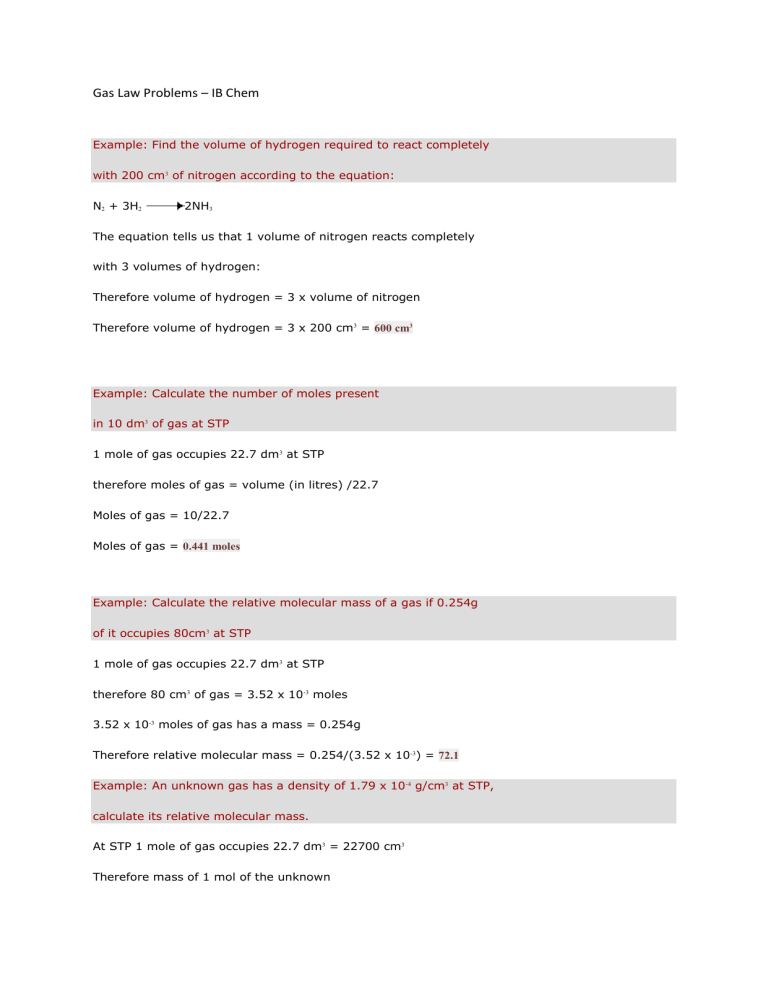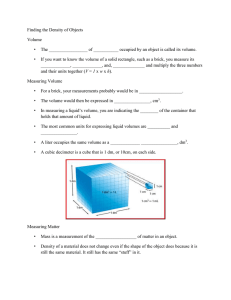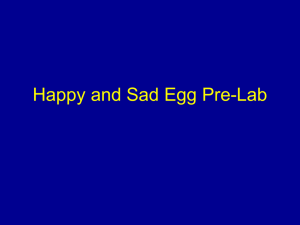
Gas Law Problems – IB Chem Example: Find the volume of hydrogen required to react completely with 200 cm3 of nitrogen according to the equation: N2 + 3H2 2NH3 The equation tells us that 1 volume of nitrogen reacts completely with 3 volumes of hydrogen: Therefore volume of hydrogen = 3 x volume of nitrogen Therefore volume of hydrogen = 3 x 200 cm3 = 600 cm3 Example: Calculate the number of moles present in 10 dm3 of gas at STP 1 mole of gas occupies 22.7 dm3 at STP therefore moles of gas = volume (in litres) /22.7 Moles of gas = 10/22.7 Moles of gas = 0.441 moles Example: Calculate the relative molecular mass of a gas if 0.254g of it occupies 80cm3 at STP 1 mole of gas occupies 22.7 dm3 at STP therefore 80 cm3 of gas = 3.52 x 10-3 moles 3.52 x 10-3 moles of gas has a mass = 0.254g Therefore relative molecular mass = 0.254/(3.52 x 10-3) = 72.1 Example: An unknown gas has a density of 1.79 x 10 -4 g/cm3 at STP, calculate its relative molecular mass. At STP 1 mole of gas occupies 22.7 dm3 = 22700 cm3 Therefore mass of 1 mol of the unknown gas at STP = 22700 x 1.79 x 10-4 g = 4.06 g The relative molecular mass of unknown gas = 4.06 Example: Calculate the pressure when 100cm3 of gas at atmospheric pressure is compressed to 10cm3 at constant temperature. Boyle's law states that PV is constant therefore the initial product of the pressure times the volume must equal the final product of the pressure times the volume, i.e.: P1V1 = P2V2 P1 = 1.01 x 105 Pa, V1 = 0.1dm3, V2 = 0.01dm3, P2 = ? P2 = (1.01 x 105 x 0.1)/0.01 P2 = 1.01 x 106 Pa Example: Calculate the volume occupied by 1 mole of gas at 35ºC at atmospheric pressure. At STP (273K, 1 atmosphere pressure) 1 mole of any gas occupies 22.7 dm3 According to Charles' Law: V1 T1 V1T2 T1 V2 T2 = = 22.7 x 308 273 New volume = 25.6 dm3 (3 sig. figs) V2 = V2 Example: Calculate the number of moles of gas present in 2.6 dm3 at a pressure of 1.01 x 105 Pa and 300 K. PV = nRT 2.6 dm3 = 0.0026 m3 0.0026 x 1.01 x 105 = n x 8.314 x 300 n = 0.0026 x 1.01 x 105 / 8.314 x 300 n = 0.105 moles Example: Calculate (i) the volume of carbon dioxide produced when 300 cm3 of methane burns in 1000 cm3 oxygen and (ii) the final volume of the reaction mixture. The equation for the reaction: CH4(g) + 2O2(g) CO2(g) + 2H2O(l) The ratio of gas volumes is 1 volume of methane reacts with 2 volumes of oxygen producing 1 volume of carbon dioxide (and liquid water, no volume) There is 300 cm3 methane - this needs 2 x 300 cm3 = 600 cm3 oxygen to burn completely and produce 1 x 300 cm3 carbon dioxide = 300cm3 carbon dioxide During the course of the reaction 300 cm3 methane and 600 cm3 of oxygen is used up from an initial total of 300 cm3 of methane and 1000 cm3 oxygen. There is 400 cm3 of oxygen in excess therefore the final mixture contains 300 cm3 carbon dioxide + 400 cm3 of oxygen = 700 cm3 of gas





